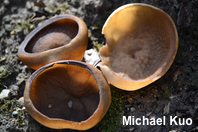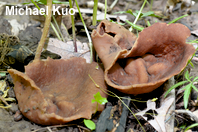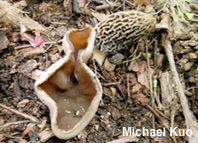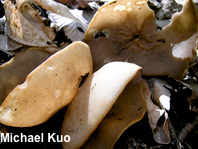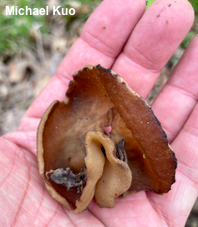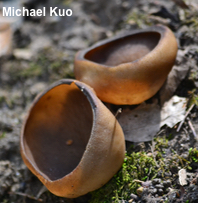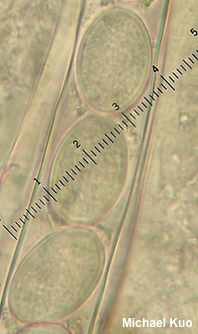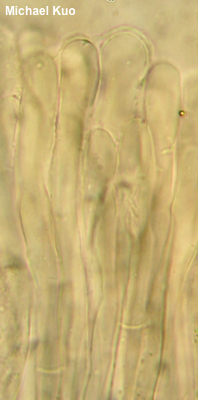| Major Groups > Cup Fungi > Disciotis venosa |

|
[ Ascomycota > Pezizales > Morchellaceae > Morchella . . . ] Disciotis venosa by Michael Kuo, 26 April 2025 Believe it or not, this cup fungus is a close relative of the Under the microscope Disciotis venosa looks quite a bit like a morel: it features large, ellipsoid spores with homogeneous contents, and paraphyses with brownish contents. Contemporary, DNA-informed study of Disciotis collections has not yet been published, so it remains uncertain whether European and North American versions of Disciotis venosa actually represent the same phylogenetic species—or whether there are multiple species involved. Description: Ecology: Uncertain; possibly saprobic and/or at least facultatively mycorrhizal; found primarily under hardwoods; growing alone, scattered, or gregariously; spring (usually during morel season); originally described from Austria (Persoon 1801); widely distributed in Europe and North America, though less common or absent in the southern areas of both continents; also documented from India. The illustrated and described collections are from Illinois, Michigan, and Ohio. Fruiting Body: 2–10 cm across; shaped more or less like a cup when young, often with a curled-in edge; in age flattening and becoming irregularly saucer-shaped. Upper Surface: Yellowish brown to brown or grayish brown; bald; often becoming pocked, wrinkled, or veined, especially over the center; the margin sometimes darkening to dark brown or even black. Excipular Surface: Whitish to pale tan, often dotted with tiny brown fibrils or scales—or appearing bald to the naked eye. Stem: Absent, but the cup is pinched together in the center where it meets the ground. Flesh: Brittle and pale brownish to whitish. Chemical Reactions: Ammonia, KOH, and iron salts all negative on upper surface and excipular surface. Odor and Taste: Not distinctive. European collections are often reported as having a bleachlike odor, but none of my North American collections has had any distinctive odor at all. Microscopic Features: Spores 19–25 x 10–15 µm; ellipsoid; smooth; with homogeneous contents; hyaline in KOH. Asci 8-spored. Paraphyses 5–12 µm wide at apex; cylindric with rounded, subclavate, clavate, or subcapitate apices; septate; hyaline or with brownish to brown contents in KOH. REFERENCES: (C. H. Persoon, 1801) L. Arnould, 1893. (Batra & Batra, 1963; Smith, Smith & Weber, 1981; Breitenbach & Kränzlin, 1984; Arora, 1986; Phillips, 1991/2005; Lincoff, 1992; Weber, 1995; O'Donnell et al., 1997; Roody, 2003; Kuo, 2005; O'Donnell et al., 2011; Buczacki et al., 2012; Beug et al., 2014; Kuo & Methven, 2014; Carris et al., 2015; Baroni, 2017; Gminder & Böhning, 2017; Læssøe & Petersen, 2019; McKnight et al., 2012.) Herb. Kuo 05299507, 04170501, 05090601, 05090603, 04270801, 05061302, 04192501. Herb. ILLS 00105085 (ASM 13701). This site contains no information about the edibility or toxicity of mushrooms. |
© MushroomExpert.Com |
|
Cite this page as: Kuo, M. (2025, April). Disciotis venosa. Retrieved from the MushroomExpert.Com Web site: http://www.mushroomexpert.com/disciotis_venosa.html. |

